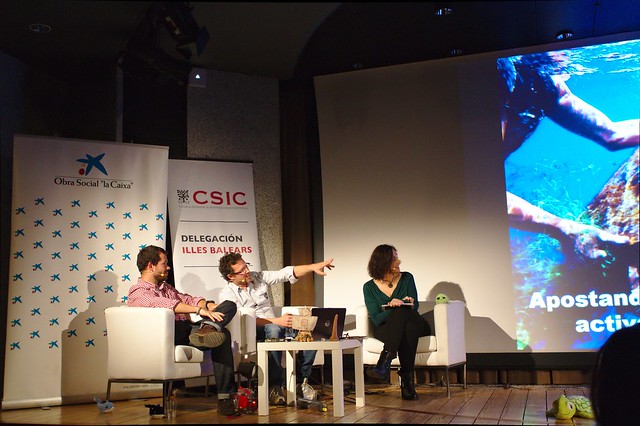
Something is moving in the Mediterranean
02/26/2016
With the objective of expanding our knowledge of the Mediterranean ecosystem and addressing the role of science in aiding its conservation, two marine scientists, David March (IMEDEA – SOCIB) and Ricardo Sagarminaga (captain and director of Kai Marine Services) sat down together last night with the journalist Rosa Campomar, at the CaixaForum Palma for the final talk in the series "Tales of the Mediterranean" organized by Obra Social "la Caixa" and UCC+i of CSIC in the Balearic Isles.
These contemporary mariners each chose to present themselves through a personal object: David March chose his underwater camera with which he explores the seabeds while Ricardo Sagarminaga chose a model of the Kon-tiki raft which he made with his daughter and which reflects his passion for marine expeditions.

Sagarminaga wanted to get the public's attention by declaring that one of the key migration corridors is found in the Mediterranean, that of the "great ocean travellers": sperm whales, sharks, turtles and dolphins. These waters are also the main spawning grounds for Bluefin tuna and feeding grounds for Bonito, Swordfish and Llampuga.
Up until now it was mainly the fishermen working in the Mediterranean who knew about the wealth of this ecosystem. Working together with the fishermen, scientists have broadened this knowledge using advanced technological tools used to track species via satellite. David March demonstrated the tracking system used to study the movement of the turtles, the true Mediterranean "oceanographers".
The marine turtles took centre stage for a large part of the talk because of their important role in the ocean: they are an oasis for thousands of species out in the open sea, an ecosystem which is comparable to the Serengeti desert. To analyse this phenomenon, Alnitak, which was last night represented by Sagarminaga, is leading the Oasis Project, with the collaboration of ICTS SOCIB, implementing the work of Dr. March.
Through this video the audience were able to immerse themselves in the research work and the conservation of our seas.

